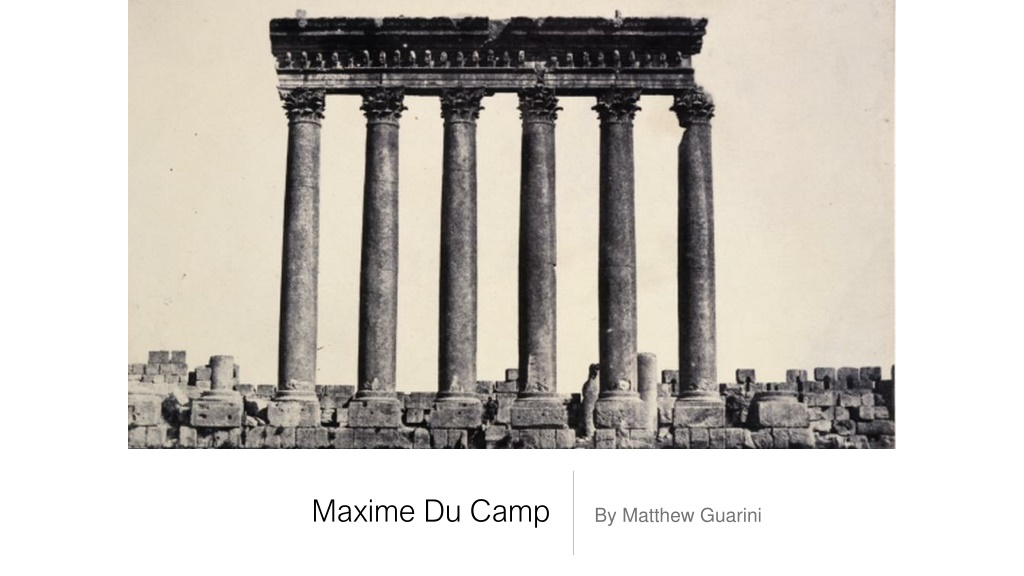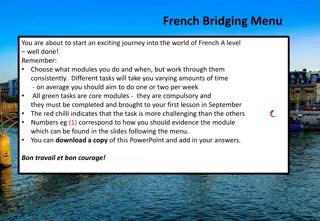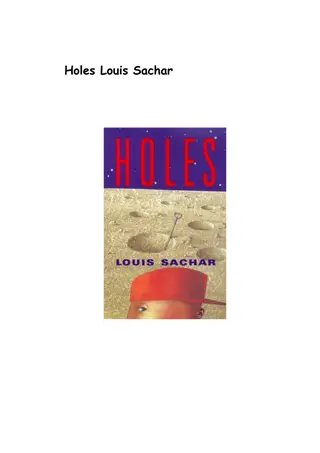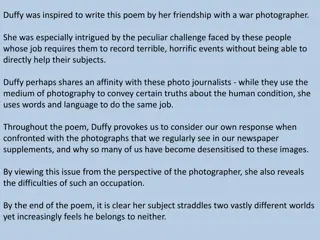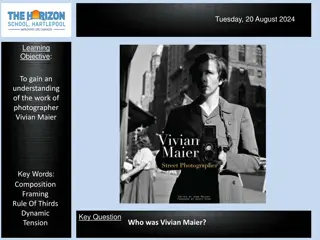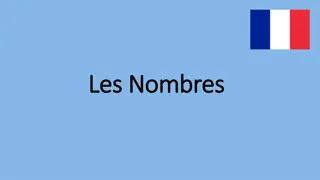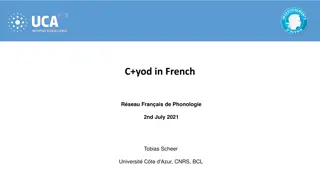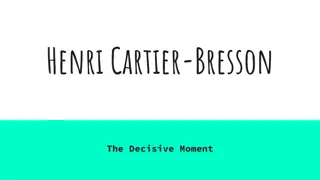Biography of Maxime Du Camp: French Photographer and Writer
Maxime Du Camp (1822-1894) was a French photographer and writer known for his exploration of Egypt with Gustave Flaubert. Their journey inspired Du Camp's renowned work, Égypte, Nubie, Palestine et Syrie, considered one of the earliest travel photography collections.
Download Presentation

Please find below an Image/Link to download the presentation.
The content on the website is provided AS IS for your information and personal use only. It may not be sold, licensed, or shared on other websites without obtaining consent from the author. Download presentation by click this link. If you encounter any issues during the download, it is possible that the publisher has removed the file from their server.
E N D
Presentation Transcript
Maxime Du Camp By Matthew Guarini
Who was Maxime Du Camp? Born 1822, died 1894 at age 72 French photographer and writer Explored Egypt with Gustave Flaubert, who later wrote Madame Bovary. Du Camp s gypte, Nubie, Palestine et Syrie is one of the first books to be illustrated using photos instead of drawings, released in 1852. Maxime Du Camp
Traveling through North Africa, Egypt, and the Middle East was not easy as an early photographer! Du Camp, Floubert, and porters had to transport a darkroom tent to each of the scouted out shooting locations. While this may have been dramatized by their diaries, they claim to have fought off bandits and rebels. They even were arrested for being spies. They had numerous encounters with native women, beer and exotic drugs along the way (they had their fun!). Gustave Flaubert, Du Camp s traveling partner
Le Sphinx, Egypt Moyenne Maxime Du Camp ca. 1855 salted paper print 15.5 x 21.0 cm. George Eastman House The Sphinx, Middle Egypt The Sphinx was still partially buried at the time of Du Camp s visit. Some of the Great Pyramids can be seen in the background.
Le Sphinx, Egypt Moyenne Maxime Du Camp White space in the sky decreases visual noise and draws attention to subjects. ca. 1855 salted paper print 15.5 x 21.0 cm. George Eastman House The image is front-lit, with the sun behind and to the left of Du Camp. The horizon line is in the center. A well-timed exposure with non- moving subjects helped keep the calotype photograph relatively sharp without much haze. Question: What do these lines signify?
Vue du Village de Hamarneh, pr s de Dend rah (Rive droite) Maxime Du Camp 1849-50 salted paper print 14.7 21.7 cm. The Metropolitan Museum of Art View of Hamarneh Village, near Dend rah (Right Bank)
Vue du Village de Hamarneh, pr s de Dend rah (Rive droite) Maxime Du Camp Parallel vertical lines in the tree trunks create a pattern and influence the viewer's eye direction. The shapes of the treetops are also repeating elements in the photo. 1849-50 salted paper print 14.7 21.7 cm. The Metropolitan Museum of Art Some fading is evident in the shadows. This photo has a low horizon line. Question: Is this photo front or backlit? What is the artistic impact?
Syrie. Baalbeck (Hliopolis) Colonnade du Temple di Soleil Maxime Du Camp ca. 1850 salted paper print 22.0 x 16.5 cm George Eastman House Colonnade of the Temple of the Sun Colonnade means row of columns!
Syrie. Baalbeck (Hliopolis) Colonnade du Temple di Soleil Maxime Du Camp Symmetrical designs draw the eye to the center of the image. ca. 1850 salted paper print 22.0 x 16.5 cm George Eastman House Another example of white space contrasted with detailed and darker subjects. Photos like this preserve visuals of a monument that may collapse with age. Lighting is uniform on the front-lit subject.
Temple D'Ombos, Haute Egypte Maxime Du Camp ca. 1855 salted paper print 16.6 x 21.9 cm. George Eastman House Ombos Temple, Upper Egypt
Temple D'Ombos, Haute Egypte Maxime Du Camp Great contrast from the light sky to the dark shadows. ca. 1855 salted paper print 16.6 x 21.9 cm. George Eastman House Vertical and diagonal eye lines are present. Detail is very strong for a calotype. While the horizon is about a third of the photo from the bottom, the subject takes up over two thirds. Question: How is scale communicated in this photo? Think of the subjects and framing.
Nubie. Kalabscheh. Sculptures de la Facade post rieure du Temple Maxime Du Camp 1850 salted paper print The Metropolitan Museum of Art Nubia. Kalabscheh. Sculptures of the rear facade of the Temple
Nubie. Kalabscheh. Sculptures de la Facade post rieure du Temple Maxime Du Camp The photo shows both the craftsmanship and age of the chiseled Egyptian art. 1850 salted paper print The Metropolitan Museum of Art The use of lighting gives us a sense of depth in the photograph. The position of the shadows tells us that the carving is inset in the bricks rather than protruding from them. Question: Why might Du Camp have chosen to omit the complete work by cropping the figure s legs?
Themes and Technical Details All photos shown fall into the landscape category, with a focus on historical architecture. Du Camp used the calotype process with the salted paper printing method. Standard writing paper was used as the media for the negatives. The tint of the photos was much warmer (more yellow/reddish) than the silvery, more black and white look of a daguerrotype. While still not as sharp as the daguerrotype, the calotype was able to be reproduced nearly endlessly from a negative, allowing Du Camp s photos to be used in his books.
Themes, continued Du Camp s photography tends to show depth and scale very well, while always seemingly alluding to a bigger picture beyond the frame. He played around with angles, from head on to side views. This variation in his positioning had an impact on the application of the rule of thirds as well as the resulting eye lines that draw viewer attention to certain spots.
Maxime Du Camp in History The age of the architecture that Maxime Du Camp photographed makes the photos he took relatively new on the timeline of Egypt. Du Camp s images have existed for less than 4% of Egypt s lifetime. Egypt: over approx. 5000 years old Du Camp s photos: about 170 years old Beginning of Ancient Egypt ~3150 BC Today Nonetheless, the impact of Du Camp s photography is a record of the earliest point in Egypt s history that an accurate, photorealistic document could be made to preserve the beautiful architecture of the past. Maxime Du Camp produced one of the world s first travel photography books, a valuable contribution to the history of photography.
Sources Images / image details - https://library.artstor.org/ Maxime Du Camp. Encyclop dia Britannica, Encyclop dia Britannica, Inc., 5 Feb. 2021, www.britannica.com/biography/Maxime-Du-Camp. Meltzer, Steve. The Birth of Travel Photography: Du Camp and Flaubert's 1849 Trip to Egypt, North Africa and the Middle East. Imaging Resource Digital Camera News RSS, 2012, www.imaging-resource.com/news/2012/10/30/the-birth-of-travel- photography-du-camp-and-flauberts-1849-trip-to-egypt.
